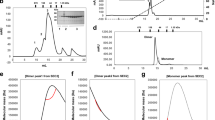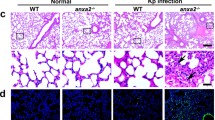Abstract
MD2, a 160-residue accessory glycoprotein, is responsible for the recognition and binding of Gram-negative bacterial membrane component, lipopolysaccharide (LPS). Internalization of pathogen inside the mononuclear phagocytes has also been attributed to MD2 which leads to the clearance of pathogens from the host. However, not much is known about the segments in MD2 that are responsible for LPS interaction or internalization of pathogen inside the defense cells. A 16-residue stretch (MD54) from MD2 protein has been identified that possesses a short heptad repeat sequence and four cationic residues enabling it to participate in both hydrophobic and electrostatic interactions with LPS. An MD54 analog of the same size was also designed in which a leucine residue at a heptadic position was replaced with an alanine residue. MD54 but not its analog, MMD54 induced aggregation of LPS and aided in its internalization within THP-1 monocytes. Furthermore, MD54 inhibited LPS-induced nuclear translocation of NF-κB in PMA-treated THP-1 and TLR4/MD2/CD14-transfected HEK-293T cells and the production of pro-inflammatory cytokines. In addition, in in vivo experiments, MD54 showed marked protection and survival of mice against LPS-induced inflammation and death. Overall, we have identified a short peptide with heptad repeat sequence from MD2 that can cause aggregation of LPS and abet in its internalization within THP-1 cells, resulting in attenuation of LPS-induced pro-inflammatory responses in vitro and in vivo.







Similar content being viewed by others
Abbreviations
- CD14:
-
Cluster of differentiation 14
- HEK-293T:
-
Human embryonic kidney cells 293
- LBP:
-
Lipopolysaccharide-binding protein
- LPS:
-
Lipopolysaccharide
- MD2:
-
Lymphocyte antigen 96
- NF-κB:
-
Nuclear factor kappa-light-chain-enhancer of activated B cells
- PAMPs:
-
Pathogen-associated molecular pattern
- PRRs:
-
Pattern recognition receptor
- TLR4:
-
Toll-like receptor 4
- PCNA:
-
Proliferating cell nuclear antigen
- ICU:
-
Intensive Care Unit
- AMP:
-
Anti-microbial peptide
References
Van Amersfoort ES, Van Berkel TJ, Kuiper J (2003) Receptors, mediators, and mechanisms involved in bacterial sepsis and septic shock. Clin Microbiol Rev 16(3):379–414
Annane D, Bellissant E, Cavaillon JM (2005) Septic shock. Lancet 365(9453):63–78. https://doi.org/10.1016/S0140-6736(04)17667-8
Hancock RE, Scott MG (2000) The role of antimicrobial peptides in animal defenses. Proc Natl Acad Sci USA 97(16):8856–8861
Rosenfeld Y, Shai Y (2006) Lipopolysaccharide (endotoxin)-host defense antibacterial peptides interactions: role in bacterial resistance and prevention of sepsis. Biochim Biophys Acta 1758(9):1513–1522. https://doi.org/10.1016/j.bbamem.2006.05.017
Fenton MJ, Golenbock DT (1998) LPS-binding proteins and receptors. J Leukoc Biol 64(1):25–32
Gioannini TL, Zhang D, Teghanemt A, Weiss JP (2002) An essential role for albumin in the interaction of endotoxin with lipopolysaccharide-binding protein and sCD14 and resultant cell activation. J Biol Chem 277(49):47818–47825. https://doi.org/10.1074/jbc.M206404200
Gioannini TL, Teghanemt A, Zhang D, Levis EN, Weiss JP (2005) Monomeric endotoxin:protein complexes are essential for TLR4-dependent cell activation. J Endotoxin Res 11(2):117–123. https://doi.org/10.1179/096805105X35198
Plociennikowska A, Hromada-Judycka A, Borzecka K, Kwiatkowska K (2015) Co-operation of TLR4 and raft proteins in LPS-induced pro-inflammatory signaling. Cell Mol Life Sci 72(3):557–581. https://doi.org/10.1007/s00018-014-1762-5
Chow JC, Young DW, Golenbock DT, Christ WJ, Gusovsky F (1999) Toll-like receptor-4 mediates lipopolysaccharide-induced signal transduction. J Biol Chem 274(16):10689–10692
Fitzgerald KA, Rowe DC, Golenbock DT (2004) Endotoxin recognition and signal transduction by the TLR4/MD2-complex. Microbes Infect 6(15):1361–1367. https://doi.org/10.1016/j.micinf.2004.08.015
Park BS, Song DH, Kim HM, Choi BS, Lee H, Lee JO (2009) The structural basis of lipopolysaccharide recognition by the TLR4–MD-2 complex. Nature 458(7242):1191–1195. https://doi.org/10.1038/nature07830
Barton GM, Medzhitov R (2003) Toll-like receptor signaling pathways. Science 300(5625):1524–1525. https://doi.org/10.1126/science.1085536
Takeda K, Akira S (2004) TLR signaling pathways. Semin Immunol 16(1):3–9
Ulevitch RJ, Tobias PS (1999) Recognition of gram-negative bacteria and endotoxin by the innate immune system. Curr Opin Immunol 11(1):19–22
Yang QW, Mou L, Lv FL, Zhu PF, Wang ZG, Jiang JX, Wang JZ (2005) Novel TLR4-antagonizing peptides inhibit LPS-induced release of inflammatory mediators by monocytes. Biochem Biophys Res Commun 329(3):846–854. https://doi.org/10.1016/j.bbrc.2005.01.162
Wang Y, Shan X, Chen G, Jiang L, Wang Z, Fang Q, Liu X, Wang J, Zhang Y, Wu W, Liang G (2015) MD-2 as the target of a novel small molecule, L6H21, in the attenuation of LPS-induced inflammatory response and sepsis. Br J Pharmacol 172(17):4391–4405. https://doi.org/10.1111/bph.13221
Srivastava RM, Srivastava S, Singh M, Bajpai VK, Ghosh JK (2012) Consequences of alteration in leucine zipper sequence of melittin in its neutralization of lipopolysaccharide-induced proinflammatory response in macrophage cells and interaction with lipopolysaccharide. J Biol Chem 287(3):1980–1995. https://doi.org/10.1074/jbc.M111.302893
Tack BF, Sawai MV, Kearney WR, Robertson AD, Sherman MA, Wang W, Hong T, Boo LM, Wu H, Waring AJ, Lehrer RI (2002) SMAP-29 has two LPS-binding sites and a central hinge. Eur J Biochem 269(4):1181–1189
Xiao Y, Dai H, Bommineni YR, Soulages JL, Gong YX, Prakash O, Zhang G (2006) Structure-activity relationships of fowlicidin-1, a cathelicidin antimicrobial peptide in chicken. FEBS J 273(12):2581–2593. https://doi.org/10.1111/j.1742-4658.2006.05261.x
Mancek M, Pristovsek P, Jerala R (2002) Identification of LPS-binding peptide fragment of MD-2, a toll-receptor accessory protein. Biochem Biophys Res Commun 292(4):880–885. https://doi.org/10.1006/bbrc.2002.6748
Yan H, Gu CG, Xu FL, Wu XH, Yin HH, Hu CX, Zhu XD, Liu F, Ge HJ, Chen LY, Zhang XY, Wang ZG, Xing Z, Li L (2013) Identification of synthetic peptides that inhibit lipopolysaccharide (LPS) binding to myeloid differentiation protein-2 (MD-2). J Immunother 36(3):197–207. https://doi.org/10.1097/cji.0b013e31828eed62
Duan GJ, Zhu J, Wan JY, Li X, Ge XD, Liu LM, Liu YS (2014) A synthetic MD-2 mimetic peptide attenuates lipopolysaccharide-induced inflammatory responses in vivo and in vitro. Int Immunopharmacol 10(9):1091–1100. https://doi.org/10.1016/j.intimp.20
Bouchayer E, Stassinopoulou CI, Tzougraki C, Marion D, Gans P (2001) NMR and CD conformational studies of the C-terminal 16-peptides of Pseudomonas aeruginosa c551 and Hydrogenobacter thermophilus c552 cytochromes. J Pept Res 57(1):39–47
Fields GB, Noble RL (1990) Solid phase peptide synthesis utilizing 9-fluorenylmethoxycarbonyl amino acids. Int J Pept Protein Res 35(3):161–214
Wild C, Oas T, McDanal C, Bolognesi D, Matthews T (1992) A synthetic peptide inhibitor of human immunodeficiency virus replication: correlation between solution structure and viral inhibition. Proc Natl Acad Sci USA 89(21):10537–10541
Oren Z, Shai Y (1997) Selective lysis of bacteria but not mammalian cells by diastereomers of melittin: structure-function study. Biochemistry 36(7):1826–1835. https://doi.org/10.1021/bi962507l
Ahmad A, Yadav SP, Asthana N, Mitra K, Srivastava SP, Ghosh JK (2006) Utilization of an amphipathic leucine zipper sequence to design antibacterial peptides with simultaneous modulation of toxic activity against human red blood cells. J Biol Chem 281(31):22029–22038. https://doi.org/10.1074/jbc.M602378200
Asthana N, Yadav SP, Ghosh JK (2004) Dissection of antibacterial and toxic activity of melittin: a leucine zipper motif plays a crucial role in determining its hemolytic activity but not antibacterial activity. J Biol Chem 279(53):55042–55050. https://doi.org/10.1074/jbc.M408881200
Ghosh JK, Ovadia M, Shai Y (1997) A leucine zipper motif in the ectodomain of Sendai virus fusion protein assembles in solution and in membranes and specifically binds biologically-active peptides and the virus. Biochemistry 36(49):15451–15462. https://doi.org/10.1021/bi971152i
Pandey BK, Srivastava S, Singh M, Ghosh JK (2011) Inducing toxicity by introducing a leucine-zipper-like motif in frog antimicrobial peptide, magainin 2. Biochem J 436(3):609–620. https://doi.org/10.1042/bj20110056
Yadav SP, Kundu B, Ghosh JK (2003) Identification and characterization of an amphipathic leucine zipper-like motif in Escherichia coli toxin hemolysin E. Plausible role in the assembly and membrane destabilization. J Biol Chem 278(51):51023–51034. https://doi.org/10.1074/jbc.M310052200
Mookherjee N, Brown KL, Bowdish DM, Doria S, Falsafi R, Hokamp K, Roche FM, Mu R, Doho GH, Pistolic J, Powers JP, Bryan J, Brinkman FS, Hancock RE (2006) Modulation of the TLR-mediated inflammatory response by the endogenous human host defense peptide LL-37. J Immunol 176(4):2455–2464
Nordahl EA, Rydengard V, Morgelin M, Schmidtchen A (2005) Domain 5 of high molecular weight kininogen is antibacterial. J Biol Chem 280(41):34832–34839. https://doi.org/10.1074/jbc.M507249200
Rallabhandi P (2010) Measuring TLR function in transfectants. Curr Protoc Immunol Chapter 14:Unit 14.16. https://doi.org/10.1002/0471142735.im1416s91
Rosenfeld Y, Papo N, Shai Y (2006) Endotoxin (lipopolysaccharide) neutralization by innate immunity host-defense peptides. Peptide properties and plausible modes of action. J Biol Chem 281(3):1636–1643. https://doi.org/10.1074/jbc.M504327200
de Haas CJ, van Leeuwen HJ, Verhoef J, van Kessel KP, van Strijp JA (2000) Analysis of lipopolysaccharide (LPS)-binding characteristics of serum components using gel filtration of FITC-labeled LPS. J Immunol Methods 242(1–2):79–89
Reinke AW, Grant RA, Keating AE (2010) A synthetic coiled-coil interactome provides heterospecific modules for molecular engineering. J Am Chem Soc 132(17):6025–6031. https://doi.org/10.1021/ja907617a
Park SC, Kim JY, Jeong C, Yoo S, Hahm KS, Park Y (2011) A plausible mode of action of pseudin-2, an antimicrobial peptide from Pseudis paradoxa. Biochim Biophys Acta 1808(1):171–182. https://doi.org/10.1016/j.bbamem.2010.08.023
Liu H, Xu R, Feng L, Guo W, Cao N, Qian C, Teng P, Wang L, Wu X, Sun Y, Li J, Shen Y, Xu Q (2012) A novel chromone derivative with anti-inflammatory property via inhibition of ROS-dependent activation of TRAF6–ASK1–p38 pathway. PLoS One 7(8):e37168. https://doi.org/10.1371/journal.pone.0037168
Thomas RC, Bath MF, Stover CM, Lambert DG, Thompson JP (2014) Exploring LPS-induced sepsis in rats and mice as a model to study potential protective effects of the nociceptin/orphanin FQ system. Peptides 61:56–60. https://doi.org/10.1016/j.peptides.2014.08.009
Fermino ML, Polli CD, Toledo KA, Liu FT, Hsu DK, Roque-Barreira MC, Pereira-da-Silva G, Bernardes ES, Halbwachs-Mecarelli L (2011) LPS-induced galectin-3 oligomerization results in enhancement of neutrophil activation. PLoS One 6(10):e26004. https://doi.org/10.1371/journal.pone.0026004
Kitchens RL, Munford RS (1998) CD14-dependent internalization of bacterial lipopolysaccharide (LPS) is strongly influenced by LPS aggregation but not by cellular responses to LPS. J Immunol 160(4):1920–1928
Kaconis Y, Kowalski I, Howe J, Brauser A, Richter W, Razquin-Olazaran I, Inigo-Pestana M, Garidel P, Rossle M, Martinez de Tejada G, Gutsmann T, Brandenburg K (2011) Biophysical mechanisms of endotoxin neutralization by cationic amphiphilic peptides. Biophys J 100(11):2652–2661. https://doi.org/10.1016/j.bpj.2011.04.041
Andra J, Koch MH, Bartels R, Brandenburg K (2004) Biophysical characterization of endotoxin inactivation by NK-2, an antimicrobial peptide derived from mammalian NK-lysin. Antimicrob Agents Chemother 48(5):1593–1599
Pulido D, Nogues MV, Boix E, Torrent M (2012) Lipopolysaccharide neutralization by antimicrobial peptides: a gambit in the innate host defense strategy. J Innate Immun 4(4):327–336. https://doi.org/10.1159/000336713
Uppu DS, Haldar J (2016) Lipopolysaccharide neutralization by cationic-amphiphilic polymers through pseudoaggregate formation. Biomacromolecules 17(3):862–873. https://doi.org/10.1021/acs.biomac.5b01567
Gangloff M, Gay NJ (2004) MD-2: the Toll ‘gatekeeper’ in endotoxin signalling. Trends Biochem Sci 29(6):294–300. https://doi.org/10.1016/j.tibs.2004.04.008
Acknowledgements
The CSIR-CDRI communication number for this article is 9609. This work was supported by a Council of Scientific and Industrial Research (CSIR) network project BioDiscovery (BSC0120). We are thankful to Dr. Douglous Golenbock (Medicine Department, University of Massachusetts Medical School, Worcester MA) and Dr. Anila Dwivedi (Endocrinology div. CSIR-CDRI, Lucknow.) for providing us with the plasmid constructs. The authors are extremely thankful to Prof. Surajit Bhattacharjya, School of Biological Sciences, Nanyang Technological University, Singapore for editing the revised version of the manuscript. The authors thankfully acknowledge the anonymous reviewers for their constructive criticism and comments in improving the quality of the manuscript. Garima Pant of Sophisticated Analytical Instrumentation Facility (SAIF) and Rima Roy from Molecular and Structural Biology Division, CSIR-CDRI are acknowledged for assistance in using the Confocal Microscope. A. L. Vishwakarma and R. K Purshottam from SAIF and CSIR-CDRI are acknowledged for assistance in using FACS and HPLC facility, respectively. We are thankful to Pharmaceutics Department for providing us the Zeta sizer instrument accessibility. We also thankfully acknowledge National Laboratory Animal Centre, CSIR-Central Drug Research Institute, Lucknow, India for providing us the animals.
Author information
Authors and Affiliations
Contributions
JKG and AT conceived the idea and designed the experiments. AT did the major part of the experiments. MKH and NI helped in western and in vivo experiments. AKT and SS assisted us in the peptide synthesis and biophysical experiments, respectively. JKG and AT analyzed the results and wrote the manuscript. All the authors were consulted on the final version of the manuscript.
Corresponding author
Ethics declarations
Conflict of interest
The authors declare no competing financial interest.
Electronic supplementary material
Below is the link to the electronic supplementary material.
Rights and permissions
About this article
Cite this article
Tandon, A., Harioudh, M., Ishrat, N. et al. An MD2-derived peptide promotes LPS aggregation, facilitates its internalization in THP-1 cells, and inhibits LPS-induced pro-inflammatory responses. Cell. Mol. Life Sci. 75, 2431–2446 (2018). https://doi.org/10.1007/s00018-017-2735-2
Received:
Revised:
Accepted:
Published:
Issue Date:
DOI: https://doi.org/10.1007/s00018-017-2735-2




